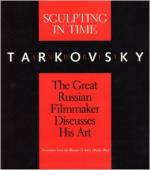|
This section contains 1,235 words (approx. 4 pages at 400 words per page) |

|
Chapter V Summary and Analysis
The artist's thought is expressed in the form of the "artistic image," which comes nearest to "conveying the artist's world." The image is "a kind of equation" between truth and the human consciousness. Tarkovsky again points to Japanese haiku poetry as the best example of narrowly-focused truth-telling. Cinema is based upon observation as its first principle. But mere observation is enough. The director-artist must capture his perception of the object, not just the object itself.
Tarkovsky points to Leonardo Da Vinci's portrait "A Young Lady With a Juniper" as a masterpiece of art. He used the portrait as part of the scene in a section of his film, Mirror. The portrait is a masterpiece because of Leonardo's amazing ability to objectively capture the subject, and because of the ambivalence the portrait stirs in the viewer. The viewer finds the...
(read more from the Chapter V Summary)
|
This section contains 1,235 words (approx. 4 pages at 400 words per page) |

|




